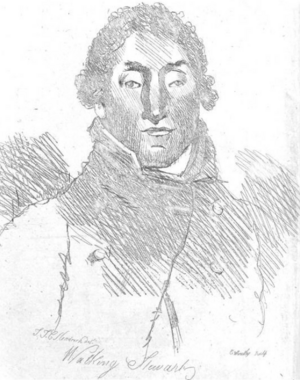Walking Stewart facts for kids
Quick facts for kids
Walking Stewart
|
|
|---|---|
 |
|
| Born |
John Stewart
19 February 1747 |
| Died | 20 February 1822 (age 75) London, England
|
John Stewart (born February 19, 1747 – died February 20, 1822) was an English philosopher and traveler. He was often called "Walking" Stewart because of his long journeys on foot. Stewart created his own special way of thinking about the world, which combined ideas about how everything is made of matter with the belief that God is in everything.
Contents
Amazing Journeys
John Stewart earned his nickname 'Walking' because he walked an incredible distance. He traveled on foot from Madras, India, all the way back to Europe. He had worked in India for a trading company called the East India Company. His journey took place between 1765 and the mid-1790s.
People believe he walked alone across many lands. These included Persia, Abyssinia (which is now Ethiopia), Arabia, and parts of Africa. After that, he explored almost every country in Europe, going as far east as Russia.
Over the next 30 years, Stewart wrote many books. He published almost 30 philosophical works. Some of his famous writings include The Opus Maximum (1803) and a long poem called The Revelation of Nature (1795). In 1796, a famous artist named James Sharples painted his picture. Sharples also painted important people like George Washington, which shows how respected Stewart was.
After his travels in India, Stewart changed his lifestyle. He became a vegetarian, meaning he did not eat meat.
His Unique Ideas
During his many travels, John Stewart developed his own special way of understanding the world. He believed that everything is made of matter, and that God is present in all things. This idea is a mix of different philosophies. It combines the idea that everything is connected, like in pantheism, with ancient Indian ideas about a single, connected consciousness.
Stewart started sharing his ideas with the public in 1790. He published two books then: Travels over the most interesting parts of the Globe and The Apocalypse of Nature.
Life in London
After his long journeys, Stewart decided to settle down in London, England. There, he became known for holding special gatherings. At these "philosophical soirées," people would meet to discuss deep ideas and thoughts.
He also gained a reputation as one of London's famous eccentrics. An eccentric person is someone who acts in unusual or quirky ways. Stewart was often seen in public wearing an old Armenian military uniform. A writer named John Timbs even wrote about him as one of London's notable eccentrics.
His Final Days
On February 20, 1822, the day after his 75th birthday, John 'Walking' Stewart passed away. His body was found in a room he rented in Northumberland Place, London. This area is close to what is now Trafalgar Square.
Impact on Writers
After his travels ended, John Stewart became good friends with several important writers. He was close with the English essayist Thomas De Quincey. He also knew Thomas Paine, who wrote many influential pamphlets. Another friend was Thomas Taylor, who studied ancient Greek philosophy.
In 1792, while in Paris, Stewart met a young poet named William Wordsworth. Wordsworth later agreed with De Quincey that Stewart was the most inspiring person they had ever met when talking about Nature. Recent studies suggest that Stewart's personality and his philosophical writings had a big impact on Wordsworth's famous poetry.
Images for kids


